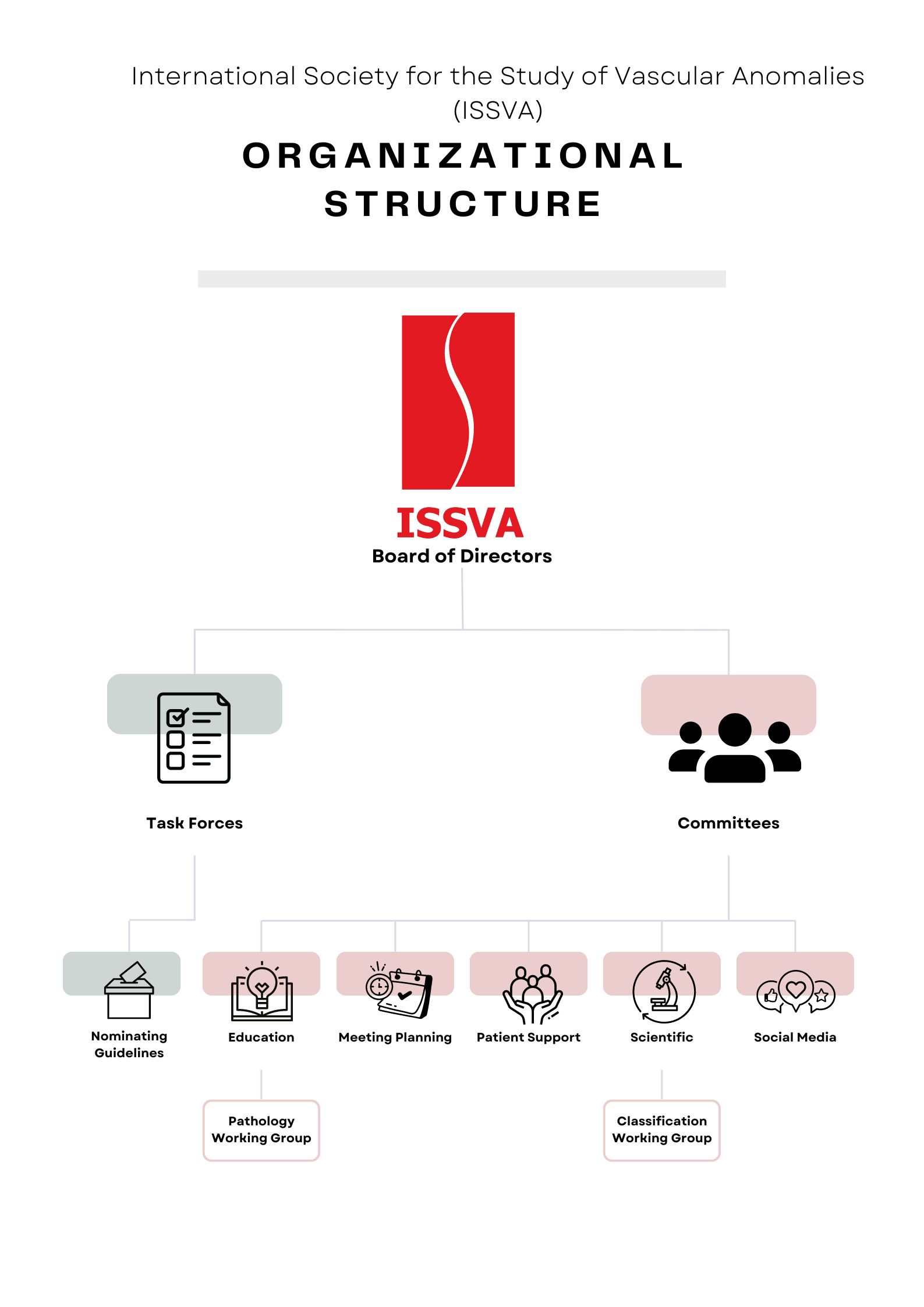

International Society for the
Study of Vascular Anomalies
| Education Committee | Pathology Working Group | Meeting Planning Committee |
| Patient Support Committee | Scientific Committee | Classification Working Group |
| Social Media Committee |

The committee application cycle for Winter 2024 has closed. Any applications submitted after 2 December 2024 will be considered for approval in Spring 2025.
Committees
Committees are established through the ISSVA bylaws as a collection of ISSVA members to such other committees and task forces as the Board shall deem appropriate. Such committees and task forces shall have the power and duties designated by the Board and shall give advice and make non-binding recommendations to the Board. Each committee will have a chair responsible for its direction, productivity, and meetings.
Working Groups
Working groups are established as a group of ISSVA members who have a common interest that affects both the Society and the specialties not covered by either a committee or task force. Working groups are formed within committees as specific areas of interest and must be approved by the ISSVA president and president-elect, committee board liaison, and committee chair prior to formation. Each working group will have a lead responsible for its direction, productivity, and meetings. This lead will be selected by the committee chair in consultation with the Board Liaison, with approval from the President and President-Elect. The lead will be a member of the committee (ex: Pathology Lead will be a member of the Education Committee) who will meet four times annually for collaboration and idea-sharing.
Task Forces
The ISSVA President proposes, and Board approves, task forces to focus on a specific issue/challenge with a timeline to complete the work necessary. When the work is complete, the task force is dissolved. Each task force will have a chair responsible for its direction, productivity, and meetings. The Chair and the members will be determined by the President and President-Elect in consultation with the Board.
The ISSVA Board of Directors has approved a Committees, Working Groups, and Task Forces Reference Manual which includes further information about the governance of these groups. This is a living document which will be updated as needed by the Board of Directors. Questions should be directed to info@issva.org or the individual committee chair or board liaison.

Chair:
Dr. Alexandra Borst
Vice Chair:
Dr. Paolo Gasparella
Board Liaison:
Dr. Denise Adams
Purpose:
Responsibilities:
The ISSVA Education Committee will explore new avenues to provide ISSVA members with the best possible educational resources including access to online services, new devices/techniques, communications, and meetings. In addition, the group explores collaborative efforts with other local, national and international VA organizations to provide educational resources and meetings to ISSVA members.
Lead:
Prof. Michel Wassef
Additional working groups may be organized under the Education Committee to operationalize projects based on areas of interest related to education with the approval of the ISSVA President, Education Committee Board Liaison, and Education Committee Chair.
Chair & Board Liaison:
Dr. Annouk-Anne Bisdorff-Bresson
Purpose:
Responsibilities:
This committee will plan the educational meetings of ISSVA other than the Congress scientific presentations. These include the pre-workshop educational sessions, breakfast sessions, and any additional free-standing ISSVA meeting(s) e.g. those dedicated to content updates, controversies, disease and management strategies. This committee will provide direction/guidance throughout the meeting planning process.
Chair:
TBA
Board Liaison:
Prof. Dr. Leo Schultze Kool
Purpose:
Responsibilities:
The Patient Support (PS) Committee is a collaborative committee, which provides ISSVA leaders and staff with guidance and direction on patient needs, resources, and education. The PS Committee will plan any patient advocacy related content including events, webinars, and other programming either by direction of the ISSVA leadership or with approval of the ISSVA Board of Directors. The PS Committee will work with the Education Committee on educational programming for patient support groups.
Chair & Board Liaison:
Dr. Dov Goldenberg
Members:
Eulalia Baselga
Gulraiz Chaudry
Anne Dompmartin
Shoshana Greenberger
Ionela Iacobas
Juan Carlos Lopez-Gutierrez
Thuy Phung
Miikka Vikkula
June Wu
Purpose:
Lead:
Dr. Miikka Vikkula
At the request of the Board and Scientific Committee Chair, the Classification Working Group will convene from the Scientific Committee Membership to recommend updates to the ISSVA Classification. The Working Group will be responsible for advising the Board when updates are needed, and maintaining accurate information for the Classification.
Chair & Board Liaison:
Dr. Gresham Richter
Purpose:
Responsibilities:
The Social Media Committee provides ISSVA leaders and staff with guidance and direction on ISSVA’s social media platforms. The Social Media Committee will plan any social media related content including the promotion of ISSVA events, webinars, and other programming either by direction of the ISSVA leadership or with approval of the ISSVA Board of Directors. The Social Media Committee will work with all ISSVA Committees, Task Forces, and Working Groups to gather related content on for posting. The Social Media Committee will also promote ISSVA’s Journal, The Journal of Vascular Anomalies, in consultation with the journal’s Editor-in-Chief.